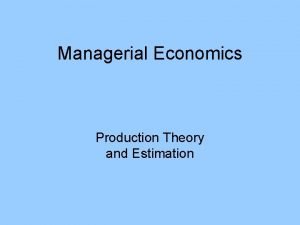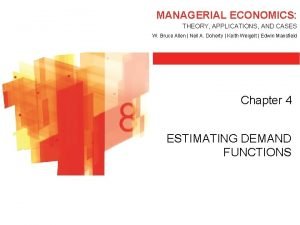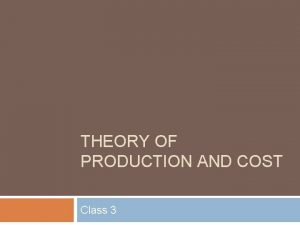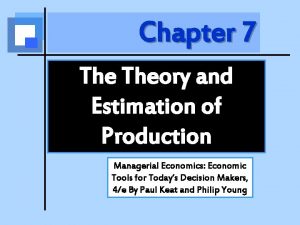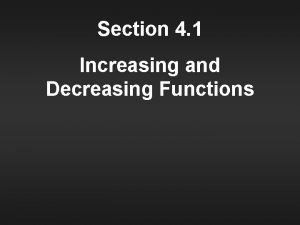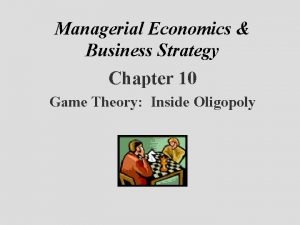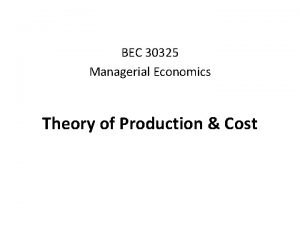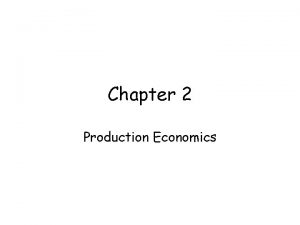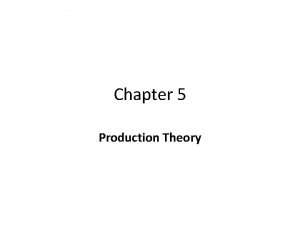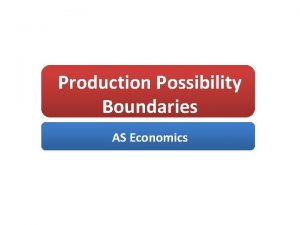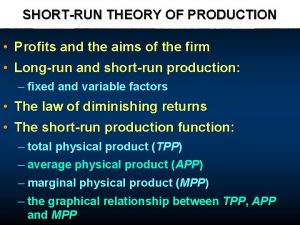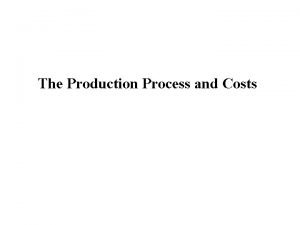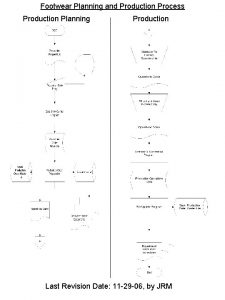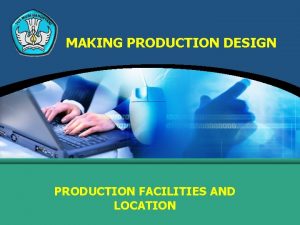Theory of Production A 2 Economics Aims and
















- Slides: 16

Theory of Production A 2 Economics

Aims and Objectives Aim: • Understand the short run theory of production. Objectives: • Define fixed, variable and total costs. • Explain the difference between SR and LR. • Analyse the effects of increasing production in the short run.

Starter Define: • Fixed Costs • Variable Costs • Total Costs

Costs Fixed Costs: • Costs of production that do not change as output varies. Variable Costs: • Costs of production that vary with output. Total Costs: • Fixed costs + Variable costs

Short Run & Long Run SR: • Period during which FC and scale of output remain fixed. LR: • Period of time during which all factors become variable and the scale of output varies.

Marginal Product • When a factory wants to increase output. • It must hire more labour to do so. MP: • The value of the output added by the extra worker.

Theory of Production Worksheet Scenario: • A vintage car manufacturing business wishes to increase its output in the short run. We assume that at least one factor of production remains constant, for example the size of the factory. To increase their output the firm has decided to hire extra workers. • Complete the table using the following formulas: – Average Product = Total Product / No of Workers – Marginal Product = Difference between the total product values for each additional worker.

No. of Workers 1 2 3 4 5 6 7 Total Product 3 7 16 28 45 60 63 Average Product Marginal Product • Now you have calculated the table above, plot on a graph the figures from the No. of Workers Column (X Axis) and the Marginal Product (Y Axis)

No. of Workers 1 2 3 4 5 6 7 Total Product 3 7 16 28 45 60 63 Average Product 3 3. 5 5. 3 7 9 10 9 Marginal Product 3 4 9 12 17 15 3 • Now you have calculated the table above, plot on a graph the figures from the No. of Workers Column (X Axis) and the Marginal Product (Y Axis)

• Comment on anything of significance that you notice. • At what No. of Workers do you think it is optimal for the firm to stop employing additional workers? Marginal Product 20 15 10 5 0 1 2 3 4 5 6 7

Increasing Marginal Returns No. of Workers 1 2 3 4 5 6 7 Total Product 3 7 16 28 45 60 63 Average Product 3 3. 5 5. 3 7 9 10 9 Marginal Product 3 4 9 12 17 15 3 Increasing Marginal Returns • Where the addition of an extra variable factor adds more to output than the previous factor.

Marginal Product 18 16 14 Increasing Marginal Returns 12 10 8 6 4 2 0 1 2 3 4 5 6 7

Law of Diminishing Marginal Returns No. of Workers 1 2 3 4 5 6 7 Total Product 3 7 16 28 45 60 63 Average Product 3 3. 5 5. 3 7 9 10 9 Marginal Product 3 4 9 12 17 15 3 Diminishing Marginal Returns • Where increasing amounts of a variable factor are added to a fixed factor and the amount added to total product by each additional unit of the variable factor eventually decreases.

Marginal Product 18 16 Diminishing Marginal Returns 14 12 10 8 6 4 2 0 1 2 3 4 5 6 7

Diminishing Marginal Returns • Why as you hire more workers might they become less productive?

Diminishing Marginal Returns • Why as you hire more workers might they become less productive? • Law economists use to explain SR production.
 Pre-production, production, post-production
Pre-production, production, post-production Objectives of teaching economics in ssc board
Objectives of teaching economics in ssc board Economics and business economics maastricht
Economics and business economics maastricht Econ213
Econ213 Empirical production function managerial economics
Empirical production function managerial economics Managerial accounting chapter 8
Managerial accounting chapter 8 Managerial economics: theory, applications, and cases
Managerial economics: theory, applications, and cases Theory of production cost
Theory of production cost Production theory and estimation
Production theory and estimation Advantage disadvantage essay
Advantage disadvantage essay Aims and objectives of increasing and decreasing functions
Aims and objectives of increasing and decreasing functions Game theory in managerial economics
Game theory in managerial economics Quantity theory of money economics
Quantity theory of money economics Quantity theory of money economics
Quantity theory of money economics What is agency problem
What is agency problem Theory of production cost
Theory of production cost Aims and objectives of teaching
Aims and objectives of teaching




